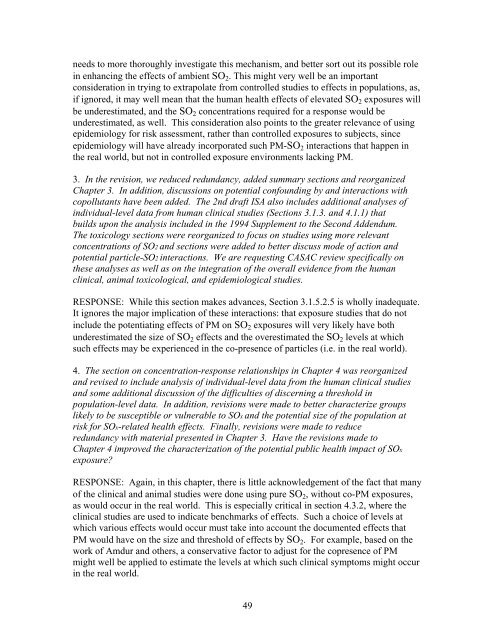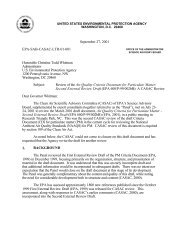(CASAC) Peer Review of EPA's Integrated Science Assessment
(CASAC) Peer Review of EPA's Integrated Science Assessment
(CASAC) Peer Review of EPA's Integrated Science Assessment
You also want an ePaper? Increase the reach of your titles
YUMPU automatically turns print PDFs into web optimized ePapers that Google loves.
needs to more thoroughly investigate this mechanism, and better sort out its possible rolein enhancing the effects <strong>of</strong> ambient SO 2 . This might very well be an importantconsideration in trying to extrapolate from controlled studies to effects in populations, as,if ignored, it may well mean that the human health effects <strong>of</strong> elevated SO 2 exposures willbe underestimated, and the SO 2 concentrations required for a response would beunderestimated, as well. This consideration also points to the greater relevance <strong>of</strong> usingepidemiology for risk assessment, rather than controlled exposures to subjects, sinceepidemiology will have already incorporated such PM-SO 2 interactions that happen inthe real world, but not in controlled exposure environments lacking PM.3. In the revision, we reduced redundancy, added summary sections and reorganizedChapter 3. In addition, discussions on potential confounding by and interactions withcopollutants have been added. The 2nd draft ISA also includes additional analyses <strong>of</strong>individual-level data from human clinical studies (Sections 3.1.3. and 4.1.1) thatbuilds upon the analysis included in the 1994 Supplement to the Second Addendum.The toxicology sections were reorganized to focus on studies using more relevantconcentrations <strong>of</strong> SO2 and sections were added to better discuss mode <strong>of</strong> action andpotential particle-SO2 interactions. We are requesting <strong>CASAC</strong> review specifically onthese analyses as well as on the integration <strong>of</strong> the overall evidence from the humanclinical, animal toxicological, and epidemiological studies.RESPONSE: While this section makes advances, Section 3.1.5.2.5 is wholly inadequate.It ignores the major implication <strong>of</strong> these interactions: that exposure studies that do notinclude the potentiating effects <strong>of</strong> PM on SO 2 exposures will very likely have bothunderestimated the size <strong>of</strong> SO 2 effects and the overestimated the SO 2 levels at whichsuch effects may be experienced in the co-presence <strong>of</strong> particles (i.e. in the real world).4. The section on concentration-response relationships in Chapter 4 was reorganizedand revised to include analysis <strong>of</strong> individual-level data from the human clinical studiesand some additional discussion <strong>of</strong> the difficulties <strong>of</strong> discerning a threshold inpopulation-level data. In addition, revisions were made to better characterize groupslikely to be susceptible or vulnerable to SOx and the potential size <strong>of</strong> the population atrisk for SOx-related health effects. Finally, revisions were made to reduceredundancy with material presented in Chapter 3. Have the revisions made toChapter 4 improved the characterization <strong>of</strong> the potential public health impact <strong>of</strong> SOxexposure?RESPONSE: Again, in this chapter, there is little acknowledgement <strong>of</strong> the fact that many<strong>of</strong> the clinical and animal studies were done using pure SO 2 , without co-PM exposures,as would occur in the real world. This is especially critical in section 4.3.2, where theclinical studies are used to indicate benchmarks <strong>of</strong> effects. Such a choice <strong>of</strong> levels atwhich various effects would occur must take into account the documented effects thatPM would have on the size and threshold <strong>of</strong> effects by SO 2 . For example, based on thework <strong>of</strong> Amdur and others, a conservative factor to adjust for the copresence <strong>of</strong> PMmight well be applied to estimate the levels at which such clinical symptoms might occurin the real world.49
















